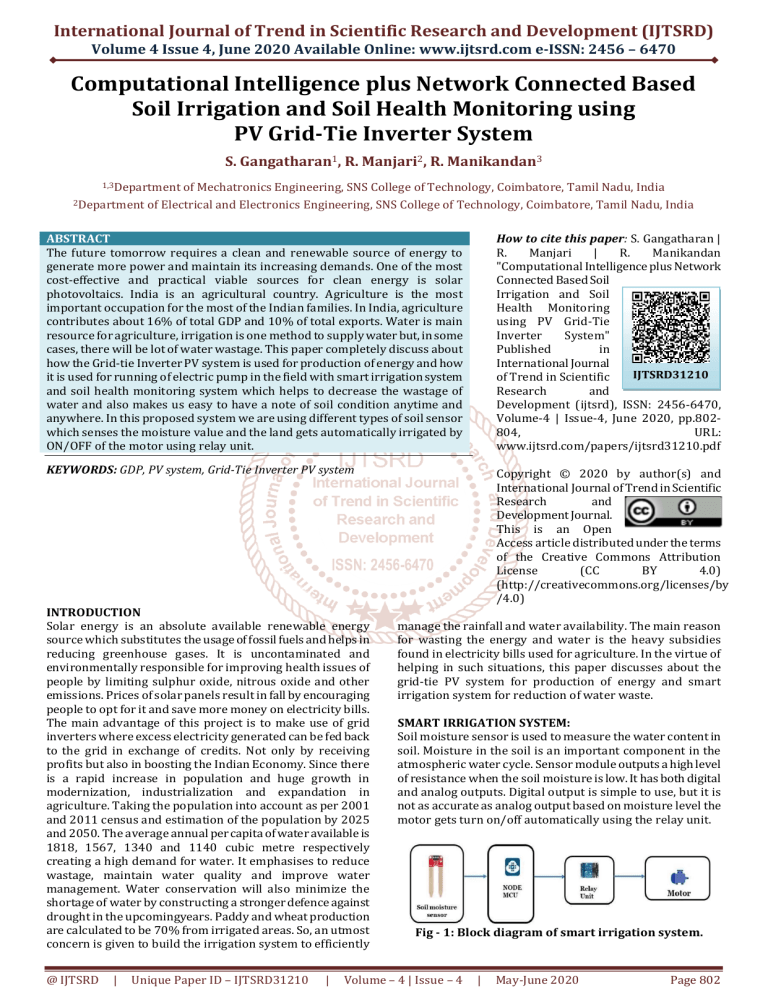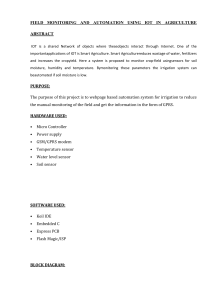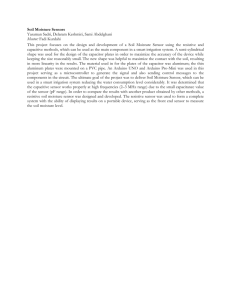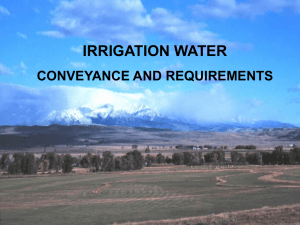
International Journal of Trend in Scientific Research and Development (IJTSRD)
Volume 4 Issue 4, June 2020 Available Online: www.ijtsrd.com e-ISSN: 2456 – 6470
Computational Intelligence plus Network Connected Based
Soil Irrigation and Soil Health Monitoring using
PV Grid-Tie Inverter System
S. Gangatharan1, R. Manjari2, R. Manikandan3
1,3Department
2Department
of Mechatronics Engineering, SNS College of Technology, Coimbatore, Tamil Nadu, India
of Electrical and Electronics Engineering, SNS College of Technology, Coimbatore, Tamil Nadu, India
ABSTRACT
The future tomorrow requires a clean and renewable source of energy to
generate more power and maintain its increasing demands. One of the most
cost-effective and practical viable sources for clean energy is solar
photovoltaics. India is an agricultural country. Agriculture is the most
important occupation for the most of the Indian families. In India, agriculture
contributes about 16% of total GDP and 10% of total exports. Water is main
resource for agriculture, irrigation is one method to supply water but, in some
cases, there will be lot of water wastage. This paper completely discuss about
how the Grid-tie Inverter PV system is used for production of energy and how
it is used for running of electric pump in the field with smart irrigation system
and soil health monitoring system which helps to decrease the wastage of
water and also makes us easy to have a note of soil condition anytime and
anywhere. In this proposed system we are using different types of soil sensor
which senses the moisture value and the land gets automatically irrigated by
ON/OFF of the motor using relay unit.
How to cite this paper: S. Gangatharan |
R.
Manjari
|
R.
Manikandan
"Computational Intelligence plus Network
Connected Based Soil
Irrigation and Soil
Health Monitoring
using PV Grid-Tie
Inverter
System"
Published
in
International Journal
IJTSRD31210
of Trend in Scientific
Research
and
Development (ijtsrd), ISSN: 2456-6470,
Volume-4 | Issue-4, June 2020, pp.802804,
URL:
www.ijtsrd.com/papers/ijtsrd31210.pdf
KEYWORDS: GDP, PV system, Grid-Tie Inverter PV system
Copyright © 2020 by author(s) and
International Journal of Trend in Scientific
Research
and
Development Journal.
This is an Open
Access article distributed under the terms
of the Creative Commons Attribution
License
(CC
BY
4.0)
(http://creativecommons.org/licenses/by
/4.0)
INTRODUCTION
Solar energy is an absolute available renewable energy
source which substitutes the usage of fossil fuels and helps in
reducing greenhouse gases. It is uncontaminated and
environmentally responsible for improving health issues of
people by limiting sulphur oxide, nitrous oxide and other
emissions. Prices of solar panels result in fall by encouraging
people to opt for it and save more money on electricity bills.
The main advantage of this project is to make use of grid
inverters where excess electricity generated can be fed back
to the grid in exchange of credits. Not only by receiving
profits but also in boosting the Indian Economy. Since there
is a rapid increase in population and huge growth in
modernization, industrialization and expandation in
agriculture. Taking the population into account as per 2001
and 2011 census and estimation of the population by 2025
and 2050. The average annual per capita of water available is
1818, 1567, 1340 and 1140 cubic metre respectively
creating a high demand for water. It emphasises to reduce
wastage, maintain water quality and improve water
management. Water conservation will also minimize the
shortage of water by constructing a stronger defence against
drought in the upcomingyears. Paddy and wheat production
are calculated to be 70% from irrigated areas. So, an utmost
concern is given to build the irrigation system to efficiently
@ IJTSRD
|
Unique Paper ID – IJTSRD31210
|
manage the rainfall and water availability. The main reason
for wasting the energy and water is the heavy subsidies
found in electricity bills used for agriculture. In the virtue of
helping in such situations, this paper discusses about the
grid-tie PV system for production of energy and smart
irrigation system for reduction of water waste.
SMART IRRIGATION SYSTEM:
Soil moisture sensor is used to measure the water content in
soil. Moisture in the soil is an important component in the
atmospheric water cycle. Sensor module outputs a high level
of resistance when the soil moisture is low. It has both digital
and analog outputs. Digital output is simple to use, but it is
not as accurate as analog output based on moisture level the
motor gets turn on/off automatically using the relay unit.
Fig - 1: Block diagram of smart irrigation system.
Volume – 4 | Issue – 4
|
May-June 2020
Page 802
International Journal of Trend in Scientific Research and Development (IJTSRD) @ www.ijtsrd.com eISSN: 2456-6470
A. ALGORITHM:
The algorithm for smart irrigation is mentioned as Follows:
Step 1: Soil moisture sensor senses the moisture level of the
soil.
Step 2: If the moisture sensed value is greater than the
threshold value than no need to switch on the motor.
Step 3: If the Moisture level is less than the threshold value,
then the switch-on motor automatically.
Step 4: Once moisture level becomes equal to the threshold
value, switch-off the motor.
Step 5: End the process.
exporting it to the grid also known as net metering. By this
the owner gets benefited more effortlessly and masterfully.
Fig-3: Block diagram of Grid-tie inverter system.
SOIL HEALTH MONITORING SYSTEM:
Soil health monitoring system comprises of 4 sensorsSoil moisture sensor, Soil temperature sensor, pH
sensor and Humidity sensor.
Soil Moisture Sensor: The Soil moisture sensor uses
capacitance to measure dielectric permittivity of the
surroundings medium. In soil, dielectric permittivity is a
function of the water content.
Soil Temperature Sensor: Soil temperature sensor is a
high-quality temperature sensor that is especially
designed for soil temperature measurement in extreme
environments.
PH sensor: pH sensor has probe that comes with them
is inserted into the soil water, and the pH can be read
directly from the display or it can be connected to any
microcontroller.
Humidity Sensor: Soil humidity sensor is used to
measure both moisture and air temperature.
Fig-2: Flow diagram of smart irrigation system.
Grid - Tie PV System:
Grid- Tie PV system is a type of On-grid PV system which
involves the direct connection of Grid-tie inverter to the grid.
When the sunlight hits the solar panel, they start producing
Direct Current. A grid tie inverter is used to invert DC power
to AC power. Firstly, panel's loading is increased slightly and
the power absorbed is measured. According to the
measurement the loading is further increased or decreased.
Inherently the output fluctuates closely by the maximum
power point of the panel. Secondly, as the GIT is designed to
adjust its feed going into the grid. The grid tie inverter
should synchronise its frequency to match with the utility
grid by an oscillator and its voltage is limited such that it
does not exceed the grid voltage. GIT's power factor is fixed,
meaning current and output voltage are accurately lined up,
and AC power grid has a phase angle below 1 degree.
In case the utility grid breaks down, the grid tie inverter has
the tendency to disconnect by preventing any harm to the
line workers who are fixing the power grid.
A typical electricity meter indicates only the power flow
through it whereas the net meter shows the amount of
electricity consumed by spinning the meter forward. If the
meter spins backward it means that a surplus electricity
generated is transmitted to the utility grid where the owner
gets the credit for excess production of electricity by
@ IJTSRD
|
Unique Paper ID – IJTSRD31210
|
Fig-4: Working diagram of soil health monitoring
system.
MOBILE APPLICATION:
The mobile application is used to know about certain
important parameters like the soil health and motor status.
The mobile application will be having a user interface which
has the ability to track the soil health by knowing the value
of different sensors connected to the micro controller via
cloud computing and also it will be having the ability to
know about the motor status at any point in time. The main
advantage of this mobile application is that with the help of
this we can have track of the soil condition and motor
operation at anytime and anywhere.
Volume – 4 | Issue – 4
|
May-June 2020
Page 803
International Journal of Trend in Scientific Research and Development (IJTSRD) @ www.ijtsrd.com eISSN: 2456-6470
and home. In this paper we have informed about the IoT
based smart irrigation system and grid-tie inverter PV
system for generation of electricity. If the proposed system is
installed in all the fields, we can contribute enormously for
the reduction of power generation from nonrenewable
sources of energy and also, we can stop the wastage of water
in the agricultural field.
REFERENCES
[1] M. R. Mojumder, A. M. Bhuiyan, H. Kadir, M. N. Shakil, A.
Rahman, “Design & analysis of an optimized Grid-Tied
PV system: Perspective Bangladesh” IACSIT
international journal of engineering and technology,
Vol.3, No. 4, August 2011.
Fig-5: User-Interface of mobile application.
OVERALL WORKING:
Soil moisture sensor, Soil Temperature sensor, pH sensor,
Humidity sensor and relay units are connected directly to
the node MCU. Node MCU is built with codes using IoT to
perform certain operation such as automatic ON/OFF of
motor pump to water the field in means of proper irrigation
and it further displays the status regarding soil health and
water pump to the owner's mobile which can be easily
accessed and monitored also the user can operate the mobile
whenever he want to actuate the motor in field. Relay unit is
attached to the pump. The main advantage of a relay unit is
to act as a switch. The circuit is incomplete when the switch
is open and complete once it is closed making the motor run.
The programming in node MCU controls the devices for
efficient functioning. The overall setup needs electricity
where we make use of Grid Tie Inverters to derive current
from the solar panels. A meter is connected in between GTI
and panel board. The excess electricity is fed to the utility
grid through the meter.
[2] T. Noguchi et al., “Short-current pulse-based maximumpower-point tracking method for multiple
photovoltaic-and-converter module system,” IEEE
Trans. Ind. Electron., vol. 49, no. 1, pp. 217–223, Feb.
2002.
[3] K. H. Hussein, “Maximum photovoltaic power tracking:
An algorithm for rapidly changing atmospheric
conditions,” Proc. Inst. Electr. Eng.—Generation,
Transmission, Distribution, vol. 142, no. 1, pp. 59–64,
Jan. 1995.
[4] M. Gohul, T. Jayach, A. M. Ali, T. G. Raju, N.Santhosh
Kumar, M.R. Saravanan, “A new design of grid tie
inverter for a grid interactive solar photovoltaic power
generation-An alternative option for energy
conservation & security” IJECT Vol. ,2, Issue 3,
Sept.2011.
[5] Archana and Priya,” Design and Implementation of
Automatic Plant Watering System” presented at
International Journal of Advanced Engineering and
Global technology, vol-04, Issue-01, Jan-2016.
[6] Sonali. D. Gainwar and Dinesh. V. Rojatkar, “Soil
Parameters Monitoring with Automatic Irrigation
System” presented at International Journal of Science,
Engineering and Technology Research (IJSETR), vol04,
Issue 11, Nov 2015.
[7] V. R. Balaji and M. Sudha , “Solar Powered Auto
Irrigation System” presented at International Journal of
Emerging Technology in Computer Science and
Electronics (IJETCSE), vol20 Issue-2, Feb-2016.
[8] R. Subalakshmi and Anu Amal, “GSM Based Automated
Irrigation using Sensors” presented at Special Issue
published in International Journal of Trend in Research
and Development (IJTRD), March- 2016.
Fig-6: Overall block diagram of the system.
CONCLUSION:
The solar systems can almost solve all the environmental
problems if it is installed in a proper manner according to
the use cases. We should make the use of renewable source
of energy like solar systems so that the non-renewable
source of energy like fossil fuels are not exhausted. Proper
grid-tie PV system setup should be developed to reduce the
use of fossil fuels. We hope there will be a time when we all
will be having Solar panels installed in all agriculture fields
@ IJTSRD
|
Unique Paper ID – IJTSRD31210
|
[9] Karan Kansara and Vishal Zaweri,” Sensor Based
Automated Irrigation System with IOT” presented at
International Journal of Computer Science and
Information Technologies, vol-06, 2015.
[10] Yunseop Kim and Robert G. Evans, “Remote Sensing
and Control of an Irrigation System using a Distributed
Wireless Sensor Network” presented at IEEE
Transactions on Instrumentation and Measurement,
Vol57, July-2008.
Volume – 4 | Issue – 4
|
May-June 2020
Page 804




